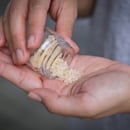
New Drug Class Available for Eczema
The new drug, Crisaborole (Eucrisa), is a topical ointment that contains a phosphodiesterase 4 enzyme inhibitor that helps reduce symptoms of itchiness and inflammation caused by atopic dermatitis.
Atopic dermatitis (AD), also known as eczema, is a skin condition experienced in 10-12% of children and 0.9% of adults in the United States (Horii, et al., 2007). Diagnosis almost always occurs in infancy and childhood however, new onset can be seen in patients over the age of 30. (Nutten, 2015).
Pruritus is considered the hallmark symptom of AD, as there is no objective test or biomarker that is used for diagnosis. (Eichenfield, et al., 2014) Other symptoms include dry skin and erythema. Oftentimes a diagnosis is made based on the location of lesions: face, neck, extensor involvement in children, flexural lesions in any age group, and sparing of the groin and axillary regions. The most common spots for lesions to occur are inside the elbows and knees and on the hands and feet. It also can present on the skin around the eyes, eyelids, eyebrows, and lashes.
Treatment of AD primarily consists of supportive treatment, such as increasing skin hydration and local moisturizers, as well as topical and systemic therapy. Topical corticosteroids (e.g. hydrocortisone) are first-line since they not only decrease acute and chronic signs of AD, but also the associated pruritus. Topical corticosteroids range from very high potency, such as clobetasol propionate, to the lowest potency such as hydrocortisone. The higher potency topical corticosteroids are used for acute exacerbation of AD and as a short-term treatment, while the lower potency is used for long-term management of AD.
Side effects of chronic topical corticosteroid use include tolerance, skin atrophy, skin thinning, and telangiectasia (spider veins). Topical calcineurin inhibitors, such as pimecrolimus (Elidel) and tacrolimus (Protopic) are used for more refractory cases of AD. However, these drugs are not recommended to be used long-term and have been associated with malignancy, similar to other immune modulators. Black Box warnings are included in the labeling for both drugs. These drugs are also not recommended in children under the age of two.
The approval of crisaborole (Eucrisa) gives clinicians another option for the treatment of mild to moderate AD in adults and children greater than the age of two. Overall, crisaborole was shown to be effective in treating patients including children with AD.
References
Eichenfield, L., Tom, W., Chamlin, S., Feldman, S., Hanifin, J., & Simpson, E. et al. (2014). Guidelines of care for the management of atopic dermatitis. Journal of the American Academy of Dermatology, 70(2), 338-351. Horii, K. A., Simon, S. D., Liu, D. Y., & Sharma, V. (2007). Atopic Dermatitis in Children in the United States, 1997 2004: Visit Trends, Patient and Provider Characteristics, and Prescribing Patterns. Pediatrics, 120(3). doi:10.1542/peds.2007-0289 Nutten, S. (2015). Atopic Dermatitis: Global Epidemiology and Risk Factors. Annals of Nutrition and Metabolism, 66(1), 8-16. doi:10.1159/000370220 Paller, A., Tom, W., Call, R., Eichenfield, L., Forsha, D., & Rees, W. et al. (2016). 033 A novel, nonsteroidal, topical, anti-inflammatory, phosphodiesterase inhibitor, Crisaborole Topical Ointment, 2%, in two phase 3 studies in children and adults with mild to moderate atopic dermatitis. Journal Of Investigative Dermatology, 136(9), S166.




